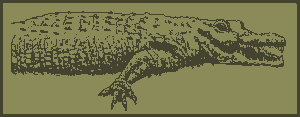|
|
|
|
|
|
Species Spotlight
on
Alligator mississipiensis

A.K.A American Alligator; Mississippi Alligator
DESCRIPTION / COLORATION Large robust body; Thick limbs; Webbed feet with claws; Muscular tail; Immense head; Color is gray or black.
SIZE Between 6.5 and 18 feet in length; Weight is between 450 and 500 pounds.
HOME Southeastern United States
HABITAT In and near swamps, lakes, and rivers of fresh or brackish water. Male alligators are usually found in deeper open waters while females seem to prefer shallow hidden areas.
LIFESTYLE Solitary; Alligators spend the bulk of their lives basking and hunting for food in or near water; Male alligators maintain and guard individual territories.
PREDATORS The adult alligators' only predators are humans. They were, at one time, nearly hunted to extinction for their skins. Today, there are many alligator farms where they are raised for their skins and meat. Young alligators are preyed upon by raccoons, otters, turtles, birds, and fish.
FOOD Young alligators feed on insects, shrimp, tadpoles, and frogs. As they grow larger they will eat fish, snakes, raccoons, muskrats, birds, and turtles.
HUNTING TECHNIQUES Most of the hunting is done in the water. Small prey is quickly grabbed and swallowed whole. Large prey animals are taken under the water, drowned, torn apart, and then eaten.
BREEDING Breeding takes place at night in April and May. The male alligator will attract the females with a roaring call. The female will lay between 20 and 60 eggs in a nest of vegetation. As the vegetation rots, it will give off heat needed to incubate the eggs. The eggs will hatch two to three months later. The female alligator will guard the young alligators for one to three years after they hatch.
LIFE SPAN 50 years.
IN CAPTIVITY The American Alligator has been kept in captivity since 1973. Although these animals have occasionally been known to become hand tamed if raised in captivity, they should never by kept by hobbyists.
SPECIAL CONCERNS As stated above, the American Alligator was once faced with extinction. In 1950, a conservation program was set up. This program worked so well that now limited hunting is allowed as well as alligator farming.
For more info see: